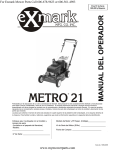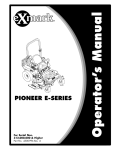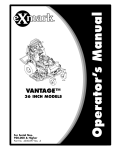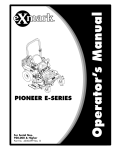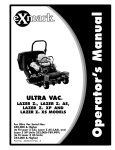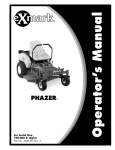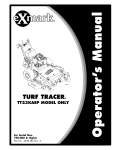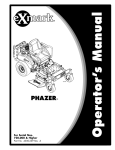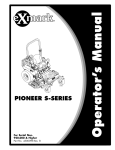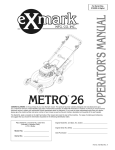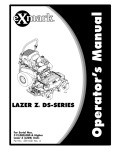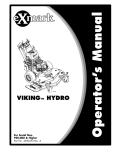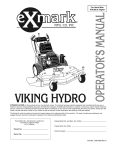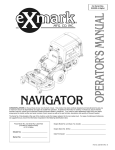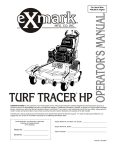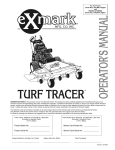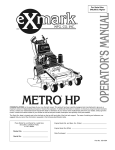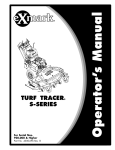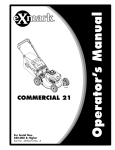Download Exmark MPKA21 User's Manual
Transcript
METRO 21 ® For Serial Nos. 790,000 & Higher Part No. 4500-400 Rev. A WARNING CALIFORNIA Proposition 65 Warning The engine exhaust from this product contains chemicals known to the State of California to cause cancer, birth defects, or other reproductive harm. Important: When the mower is used or operated on any California forest, brush or grass covered land, a working spark arrester must be attached to the muffler. If not, the operator is violating state law, Section 4442 Public Resource Code. To acquire a spark arrester for your unit, see your Engine Service Dealer. This spark ignition system complies with Canadian ICES-002 Ce système d’allumage par ètincelle de vèhicule est conforme à la norme NMB-002 du Canada The enclosed Engine Owner’s Manual is supplied for information regarding The U.S. Environmental Protection Agency (EPA) and the California Emission Control Regulation of emission systems, maintenance and warranty. Keep this engine Owner’s Manual with your unit. Should this engine Owner’s Manual become damaged or illegible, replace immediately. Replacements may be ordered through the engine manufacturer. Exmark reserves the right to make changes or add improvements to its products at any time without incurring any obligation to make such changes to products manufactured previously. Exmark, or its distributors and dealers, accept no responsibility for variations which may be evident in the actual specifications of its products and the statements and descriptions contained in this publication. © 2008—Exmark Mfg. Co., Inc. Industrial Park Box 808 Beatrice, NE 68310 2 Contact us at www.Exmark.com. Printed in the USA All Rights Reserved Introduction CONGRATULATIONS on the purchase of your Exmark Mower. This product has been carefully designed and manufactured to give you a maximum amount of dependability and years of trouble-free operation. This manual contains operating, maintenance, adjustment, and safety instructions for your Exmark mower. Figure 1 BEFORE OPERATING YOUR MOWER, CAREFULLY READ THIS MANUAL IN ITS ENTIRETY. 1. Model and serial number location By following the operating, maintenance, and safety instructions, you will prolong the life of your mower, maintain its maximum efficiency, and promote safe operation. Model No. Serial No. If additional information is needed, or should you require trained mechanic service, contact your authorized Exmark equipment dealer or distributor. All Exmark equipment dealers and distributors are kept informed of the latest methods of servicing and are equipped to provide prompt and efficient service in the field or at their service stations. They carry ample stock of service parts or can secure them promptly for you from the factory. All Exmark parts are thoroughly tested and inspected before leaving the factory, however, attention is required on your part if you are to obtain the fullest measure of satisfaction and performance. Whenever you need service, genuine Exmark parts, or additional information, contact an Authorized Service Dealer or Exmark Customer Service and have the model and serial numbers of your product ready. Figure 1 identifies the location of the model and serial numbers on the product. Write the numbers in the space provided. 3 Contents Emptying the Fuel Tank and Cleaning the Fuel Filter (Kawasaki Units Only)......................................................... 34 Waste Disposal .............................................. 34 Storage ................................................................. 35 Preparing the Fuel System.............................. 35 Preparing the Engine ..................................... 35 General Storage Information ......................... 35 Removing the Lawn Mower from Storage...................................................... 35 Troubleshooting ................................................... 36 Introduction ........................................................... 3 Safety ..................................................................... 5 Safety Alert Symbol ......................................... 5 Safe Operating Practices .................................. 5 Safety and Instructional Decals ....................... 9 Specifications ....................................................... 12 Model Numbers ............................................ 12 Systems ......................................................... 12 Dimensions................................................... 12 Product Overview ................................................ 13 Operation ............................................................. 14 Controls ........................................................ 14 Pre-Start........................................................ 15 Operating Instructions .................................. 16 Maintenance ......................................................... 23 Recommended Maintenance Schedule(s) ........... 23 Periodic Maintenance ....................................... 24 Check Engine Oil Level ................................. 24 Checking the Blade Brake Clutch (For Units with a Blade Brake Clutch Only)......................................................... 24 Check the Mower Blade ................................. 24 Check for Loose Hardware ............................ 26 Service Air Filter(Kawasaki Units) ................. 26 Service Air Filter(Honda Units) ..................... 27 Change Engine Oil ........................................ 28 Changing the Oil Filter (Kawasaki Units Only):........................................................ 28 Servicing the Wheels ..................................... 29 Check Condition Of Belt(Self-Propelled Units Only) ............................................... 29 Lubricate the Pivot Arms............................... 29 Lubricate the Gear Case(Self-Propelled Units Only) ............................................... 30 Check Spark Plugs ......................................... 30 Adjustments ..................................................... 31 Adjusting the Self-Propel Drive(Self-Propelled Units Only) ............... 31 Adjusting the Blade Brake Cable .................... 31 Cleaning ........................................................... 32 Clean Grass Build-Up Under Deck ................ 32 Cleaning the Discharge Tunnel and Plug........................................................... 32 Cleaning Under the Belt Cover(Self-Propelled Models Only) ........... 33 Cleaning the Blade Brake Clutch Shield ........................................................ 33 4 Safety Safety Safe Operating Practices Safety Alert Symbol Training This lawn mower meets or exceeds the CPSC blade safety requirements for walk-behind rotary mowers and the B71.4 specifications of the American National Standards Institute in effect at the time of production • Read the Operator’s Manual and other training material. If the operator(s) or mechanic(s) can not read English it is the owner’s responsibility to explain this material to them. • Become familiar with the safe operation of the equipment, operator controls, and safety signs. Exmark designed and tested this lawn mower to offer reasonably safe service; however, failure to comply with the following instructions may result in personal injury. • All operators and mechanics should be trained. The owner is responsible for training the users. • Never let children or untrained people operate or service the equipment. Local regulations may restrict the age of the operator. This Safety Alert Symbol (Figure 2) is used both in this manual and on the machine to identify important safety messages which must be followed to avoid accidents • The owner/user can prevent and is responsible for accidents or injuries occurring to himself or herself, other people or property. This symbol means: ATTENTION! BECOME ALERT! YOUR SAFETY IS INVOLVED! Preparation • Evaluate the terrain to determine what accessories and attachments are needed to properly and safely perform the job. Only use accessories and attachments approved by Exmark. Figure 2 1. Safety alert symbol • Wear appropriate clothing including safety glasses, substantial footwear, long trousers, and hearing protection. Do Not operate when barefoot or when wearing open sandals. Long hair, loose clothing or jewelry may get tangled in moving parts. The safety alert symbol appears above information which alerts you to unsafe actions or situations and will be followed by the word DANGER, WARNING, or CAUTION. DANGER: White lettering / Red background. Indicates an imminently hazardous situation which, if not avoided, Will result in death or serious injury. CAUTION WARNING: Black lettering / Orange background. Indicates a potentially hazardous situation which, if not avoided, Could result in death or serious injury. This machine produces sound levels in excess of 85 dBA at the operator’s ear and can cause hearing loss through extended periods of exposure. CAUTION: Black lettering / Yellow background. Indicates a potentially hazardous situation which, if not avoided, May result in minor or moderate injury. Wear hearing protection when operating this machine. This manual uses two other words to highlight information. Important calls attention to special mechanical information and Note emphasizes general information worthy of special attention. • Inspect the area where the equipment is to be used and remove all rocks, toys, sticks, wires, bones, and other foreign objects which can be thrown by the machine and may cause personal injury to the operator or bystanders. 5 Safety DANGER DANGER In certain conditions gasoline is extremely flammable and vapors are explosive. A fire or explosion from gasoline can burn you, others, and cause property damage. In certain conditions during fueling, static electricity can be released causing a spark which can ignite gasoline vapors. A fire or explosion from gasoline can burn you and others and cause property damage. • Fill the fuel tank outdoors in an open area, when the engine is cold. Wipe up any gasoline that spills. • Always place gasoline containers on the ground away from your vehicle before filling. • Never refill the fuel tank or drain the machine indoors or inside an enclosed trailer. • Do Not fill gasoline containers inside a vehicle or on a truck or trailer bed because interior carpets or plastic truck bed liners may insulate the container and slow the loss of any static charge. • Do Not fill the fuel tank completely full. Add gasoline to the fuel tank until the level is 1/4 to 1/2 inch (6–13 mm) below the bottom of the filler neck. This empty space in the tank allows gasoline to expand. • When practical, remove gas-powered equipment from the truck or trailer and refuel the equipment with its wheels on the ground. • Never smoke when handling gasoline, and stay away from an open flame or where gasoline fumes may be ignited by spark. • If this is not possible, then refuel such equipment on a truck or trailer from a portable container, rather than from a gasoline dispenser nozzle. • Store gasoline in an approved container and keep it out of the reach of children. • If a gasoline dispenser nozzle must be used, keep the nozzle in contact with the rim of the fuel tank or container opening at all times until fueling is complete. • Add fuel before starting the engine. Never remove the cap of the fuel tank or add fuel when engine is running or when the engine is hot. WARNING • If fuel is spilled, Do Not attempt to start the engine. Move away from the area of the spill and avoid creating any source of ignition until fuel vapors have dissipated. Gasoline is harmful or fatal if swallowed. Long-term exposure to vapors has caused cancer in laboratory animals. Failure to use caution may cause serious injury or illness. • Do Not operate without entire exhaust system in place and in proper working condition. • Avoid prolonged breathing of vapors. • Keep face away from nozzle and gas tank/container opening. • Keep away from eyes and skin. • Never siphon by mouth. • Check that the operator’s presence controls, safety switches, and shields are attached and functioning properly. Do Not operate unless they are functioning properly. 6 Safety Operation • Never attempt to make wheel height adjustments while the engine is running. WARNING • Stop engine, wait for all moving parts to stop, remove the spark plug wire(s) and/or remove key. Operating engine parts, especially the muffler, become extremely hot. Severe burns can occur on contact and debris, such as leaves, grass, brush, etc. can catch fire. – Before checking, cleaning or working on the mower. – After striking a foreign object or abnormal vibration occurs (inspect the mower for damage and make repairs before restarting and operating the mower). • Allow engine parts, especially the muffler, to cool before touching. • Remove accumulated debris from muffler and engine area. – Before clearing blockages. – Whenever you leave the mower. • Install and maintain in working order a spark arrester before using equipment on forest-covered, grass-covered, or brush-covered unimproved land. • Stop engine, wait for all moving parts to stop: – Before refueling. – Before dumping the grass catcher. – Before making height adjustments. WARNING WARNING Engine exhaust contains carbon monoxide, which is an odorless deadly poison that can kill you. Hands, feet, hair, clothing, or accessories can become entangled in rotating parts. Contact with the rotating parts can cause traumatic amputation or severe lacerations. Do Not run engine indoors or in a small confined area where dangerous carbon monoxide fumes can collect. • Do Not operate the machine without guards, shields, and safety devices in place and working properly. • Operate only in daylight or good artificial light, keeping away from holes and hidden hazards. • Start the engine carefully according to instructions with feet well away from the blades. • Never raise deck with blades running. • Never operate the mower with damaged guards, shields, or covers. Always have safety shields, guards, switches and other devices in place and in proper working condition. • Never mow with the discharge deflector raised, removed or altered unless there is a grass collection system or mulch kit in place and working properly. • Grass catcher components are subject to wear, damage and deterioration, which could expose moving parts or allow objects to be thrown. Frequently check the components and replace them with the manufacturer’s recommended parts when necessary. • Do Not change the engine governor setting or overspeed the engine. • Keep hands, feet, hair, jewelry, or clothing away from rotating parts. • Keep clear of the discharge opening at all times. • To extend the life the engine brake, place the throttle control in the “slow” position; then stop the engine. • This mower was designed for one operator only. Keep all others away from mower during operation. • DO NOT operate the mower when people, especially children, or pets are in the area. • Be alert, slow down and use caution when making turns. Look behind and to the side before changing directions. • Stop the blades, slow down, and use caution when crossing surfaces other than grass and when transporting the mower to and from the area to be mowed. 7 Safety Maintenance and Storage • Be aware of the mower discharge path and direct discharge away from others. • Do Not operate the mower under the influence of alcohol or drugs. • Use extreme care when loading or unloading the machine into a trailer or truck. • Use care when approaching blind corners, shrubs, trees, or other objects that may obscure vision. • Stop the engine and remove the spark plug wire(s) and/or remove key. Wait for all movement to stop before adjusting, cleaning or repairing. • Keep engine and engine area free from accumulation of grass, leaves, excessive grease or oil, and other debris which can accumulate in these areas. These materials can become combustible and may result in a fire. Slope Operation • Let engine cool before storing and Do Not store near flame or any enclosed area where open pilot lights or heat appliances are present. Use Extreme caution when mowing and/or turning on slopes as loss of traction and/or tip-over could occur. The operator is responsible for safe operation on slopes. • Shut off fuel while storing or transporting. Do Not store fuel near flames or drain indoors. • Park machine on level ground. Never allow untrained personnel to service machine. DANGER Operating on wet grass or steep slopes can cause sliding and loss of control. Loss of control and/or loss of operator’s footing could result in a fall with an arm or leg getting under the mower or engine deck which may result in serious injury, death or drowning. • Remove spark plug wire before making any repairs. • Mow across slopes, never up and down. • Keep hands and feet away from moving parts. If possible, Do Not make adjustments with the engine running. • Use care when checking blades. Wrap the blade(s) or wear gloves, and use caution when servicing them. Only replace blades. Never straighten or weld them. • Do Not mow slopes when grass is wet. • Do Not mow near drop-offs or near water. • Do Not mow excessively steep slopes. • Keep all guards, shields and all safety devices in place and in safe working condition. • Reduce speed and use extreme caution on slopes. • Check all bolts frequently to maintain proper tightness. • Avoid sudden turns or rapid speed changes. • Frequently check for worn or deteriorating components that could create a hazard. • All replacement parts must be the same as or equivalent to the parts supplied as original equipment. • When feasible, avoid operating the equipment in wet grass. • Progressively greater care is needed as the slope increases. • Remove or mark obstacles such as rocks, tree limbs, etc. from the mowing area. Tall grass can hide obstacles. • Watch for ditches, holes, rocks, dips and rises that change the operating angle, as rough terrain could overturn the machine. • Use extreme care with grass catchers or attachments. These can change the stability of the machine and cause loss of control. 8 Safety Safety and Instructional Decals • Keep all safety signs legible. Remove all grease, dirt and debris from safety signs and instructional labels. • Replace all worn, damaged, or missing safety signs. • When replacement components are installed, be sure that current safety signs are affixed to the replaced components. • If an attachment or accessory has been installed, make sure current safety signs are visible. • New safety signs may be obtained from your authorized Exmark equipment dealer or distributor or from Exmark Mfg. Co. Inc. • Safety signs may be affixed by peeling off the backing to expose the adhesive surface. Apply only to a clean, dry surface. Smooth to remove any air bubbles. • Familiarize yourself with the following safety signs and instruction labels. They are critical to the safe operation of your Exmark commercial mower. 52-2610 For Push Units (MPKA21 and MPKA21CA) 39-5770 For Units without a Blade Brake Clutch (MPKA21, MPKA21CA, MSKA21, MSKA21CA, and MSHN21) 52-2620 For Self-Propelled Units (MSKA21, MSKA21CA, MSKA21B, MSKA21BCA, MSHN21, and MSHN21B) 68-7410 Common to All Units 43-8480 For Units with a Blade Brake Clutch (MSKA21B, MSHN21B, and MSKA21BCA) 9 Safety 74-1970 For Self-Propelled Units (MSKA21, MSKA21CA, MSKA21B, MSKA21BCA, MSHN21, and MSHN21B) 1. Transmission speeds 2. Neutral 77-0500 Common to All Units 103-6328 For MSKA21B and MSHN21B Units Only 1. Choke 2. Fast 3. Continuous variable setting 4. Slow 5. Engine—stop 93-7398 Common to All Units 104-1329 Common to All Units 104-8585 Common to All Units 103-6327 For MPKA21, MSKA21, and MSHN21 Units Only 1. Choke 2. Fast 3. Continuous variable setting 4. Slow 10 Safety 109-8190 On MPKA21CA and MSKA21CA Units Only 1. Fast 2. Continuous variable setting 3. Slow 109-8191 On MPKA21CA, MSKA21CA, and MSKA21BCA Units Only 109-8194 On MSKA21BCA Units Only 1. Fast 2. Continuous variable setting 3. Slow 4. Engine—stop 11 Specifications Specifications Model Numbers Serial Nos: 790,000 and Higher MPKA21; MPKA21CA; MSKA21; MSKA21CA; MSKA21B; MSKA21BCA; MSHN21; MSHN21B Systems Cutting Deck • Cutting Width: 21 inches (53.3 cm) Engine • Blade Brake: When the blade engagement control is moved to the disengaged position a friction brake pad stops the rotation of the blades. • Engine Specifications: See your Engine Owner’s Manual • RPM: 3300 (No Load) • Blade Size: (1 ea.): 20.88 inches (53.0 cm) • Deck: 21 inches rigid. Deck design allows for bagging, mulching or side discharge. Fuel System • Capacity: • Cutting Height Adjustment: MPKA21, MSKA21, and MSKA21B Units: 4.0 qt (3.8 L) Adjusts from 3/4 inches (1.9 cm) to 3 1/4 inches (8.3 cm) in 1/2 inch (1.3 cm) increments. MPKA21CA, MSKA21CA, and MSKA21BCA Units: 2.1 qt (2.0 L) • Mulching Kit: Standard Honda Units: 2.1 qt (2.0 L) • Side Discharge Kit: Optional • Type of Fuel: Regular unleaded gasoline, 87 octane or higher. • Fuel Filter: Non-replaceable, in tank • Fuel Shut-Off Valve: MPKA21, MSKA21, and MSKA21B and Honda Units: In-line 1/4 turn increments. Dimensions Curb Weight: 122 lb (55 kg) Weights may vary slightly depending on engine option. MPKA21CA, MSKA21CA, and MSKA21BCA Units Do Not have a shut-off valve. Overall Width: Safety Interlock System 22.25 inches (56.5 cm) For units without a Blade Brake Clutch: Operator must have the blade control bail depressed to start the engine. Releasing the blade control bail will cause the engine to stop. Transmission (Self Propelled Units) 3 speeds forward Speed Range: • 1st–2.0 mph (3.2 km/hr) • 2nd–2.9 mph (4.6 km/hr) • 3rd–4.1 mph (6.6 km/hr) 12 Product Overview Overall Length and Height at 2 1/4 inch Cutting Height: Handle Setting Length Height High 60.50 inches (153.7 cm) 42.75 inches (108.6 cm) Medium 64.25 inches (163.2 cm) 40.38 inches (102.6 cm) Low 67.00 inches (170.2 cm) 37.88 inches (96.2 cm) Product Overview Overall Length and Height at Alternate Handle Mounting Position: Handle Setting Length Height High 62.63 inches (159.1 cm) 37.50 inches (95.3 cm) Medium 64.38 inches (163.5 cm) 35.50 inches (90.2 cm) 66.25 inches (168.3 cm) 33.63 inches (85.4 cm) Low Figure 3 1. Spark plug 2. 3. 4. 5. 8. Drive Bail (Self-Propelled Units Only) 9. Throttle/Choke control 10. Fuel tank 11. Oil filter 12. Air filter Oil fill/dipstick Discharge door handle Grass bag Blade Control Lever (Blade Brake Units Only) 6. Blade Control Bail 13. Cutting height lever 7. Handle 13 Operation Operation control lever. When this bail is released the unit will stop moving. Note: Determine the left and right sides of the machine from the normal operating position. Throttle-Choke Control Controls The throttle-choke control is located on the left side of the handles as shown in Figure 4. Blade Control Bail The lever is used to control engine speed. Moving the lever to the full forward (Choke) position will place the lever in the choke position. The choke aids in starting a cold engine. Moving the throttle control forward will increase engine speed and moving it to the rear will decrease engine speed. Located on the upper handle as shown in Figure 4. When the blade control bail is depressed, the system senses that the operator is in the normal operator’s position. • For Units with a Blade Brake Clutch: When the blade control bail is released, the system senses that the operator has moved from the normal operating position and will stop the blade. • For Units without a Blade Brake Clutch: When the blade control bail is released, the system senses that the operator has moved from the normal operating position and will kill the engine. For units with a Blade Brake Control: The throttle-choke control also includes an engine kill position. Moving the lever into the full rearward (Off) position will kill the engine. Note: MPKA21CA, MSKA21CA, and MSKA21BCA Units Do Not have a choke. Blade Control Lever (Blade Brake Clutch Units Only): The blade control lever is located on the right side of the handle next to the Blade Control Bail as shown in Figure 4. Moving the blade control lever into the full forward position while depressing the blade control bail engages the blade. Releasing the blade control bail automatically disengages the blades. Ground Speed (Shifter) Control (Self-Propelled Units Only): The ground speed control is located at the rear of the belt cover as shown in Figure 5. Figure 4 4. Handle 1. Throttle-Choke Control 5. Drive Bail 2. Blade Control Lever (Self-Propelled Units (Blade Brake Units Only) Only) 3. Blade Control Bail The ground speed control has three settings which control the ground speed of the mower: 1 is slow, 2 is medium, and 3 is fast. Self-Propel Drive Bail (For Self-Propelled Units Only) Located on the upper handle as shown in Figure 4. When the self-propel drive bail is squeezed, the unit will move forward at the speed set on the speed 14 Operation Figure 5 1. Ground speed control Figure 7 MSHN21 and MSHN21B Units Fuel Shut-Off Valve 1. Fuel valve For MPKA21, MSKA21, and MSKA21B Units: The fuel shut off valve is installed on the fuel line midway between the fuel tank and the engine as shown in Figure 6. For MPKA21CA, MSKA21CA, and MSKA21BCA Units:Do not have a fuel shut off valve. The fuel shut off valve shuts off the flow of fuel when the machine will not be used for a few days, when parking inside a building, and during transport to and from the job. Rotate the valve 1/4 turn clockwise to shut off fuel. Rotate the valve 1/4 turn counterclockwise to turn on fuel. Pre-Start Fill fuel tank. For best results use only clean, fresh regular grade unleaded gasoline with an octane rating of 87 or higher. To ensure freshness, purchase only the quantity of gasoline that you expect to use in 30 days. Using unleaded gasoline results in fewer combustion deposits and longer engine life. See Engine Owner’s Manual. Figure 6 MPKA21, MSKA21, and MSKA21B Units 1. Fuel line 2. Fuel valve 3. Elbow fitting Do Not add oil to gasoline. For MSHN21 and MSHN21B Units: The fuel shut off valve is located on the engine as shown in Figure 7. Do Not use methanol, gasoline containing methanol, gasohol containing more the 10% ethanol, premium gasoline or white gas. Using these fuels can damage the engine’s fuel system. Do Not use gasoline that has been stored since the last mowing season or longer. Do Not overfill fuel tank. Never fill the fuel tank so that the fuel level rises above a level that is 1/2 inch below the bottom of the filler neck to allow for fuel expansion and prevent fuel spillage. 15 Operation Make sure you understand the controls, their locations, their functions, and their safety requirements. 1. Install the hardware in the lower holes in the handle and latches as shown in Figure 8. 2. Install hardware in one of the three adjustment holes in the upper ends of each of the handle latches to obtain the desired handle height within the selected range. Refer to the Maintenance section and perform all the necessary inspection and maintenance steps. Operating Instructions 3. Slide the bag support rod through into the upper, middle, or lower mounting holes in the handle and secure each end with a cap locknut. The bag support rod mounting hole location corresponds with the mounting hole location for the handle latches as shown in the table. Handle Adjustment The handle may be adjusted to different heights for comfortable operation. Stand behind the handle to determine the height. to adjust the handle height, position the capscrews and the locknuts that secure the handle latches to the handle into the other mounting holes in the latches. See Figure 8A for the highest possible handle heights. See Figure 8B for the lowest possible handle heights. Bag Support Rod Mounting Hole Location Handle Latch Mounting Hole Location Lower Lower Middle Middle Upper Upper Open the Fuel Shut-Off Valve Rotate the valve 1/4 turn counterclockwise to turn the fuel on. Starting the Engine 1. Connect the wire to the spark plug. For MSHN21 and MSHN21B Units: see Figure 9. For MPKA21, MSKA21, MSKA21B, MPKA21CA, MSKA21CA, and MSKA21BCA Units: see Figure 10. Figure 8 1. Handle latch 2. Adjustment holes in upper end of handle latch 3. Handle 4. Spring disc washer 5. 5/16-18 x 1 3/8 inch hex capscrew 6. 5/16-18 x 1 1/4 inch hex capscrew 16 Operation For MSHN21 and MSHN21B Units: see Figure 7. MPKA21CA, MSKA21CA, and MSKA21BCA Units: Do Not have a fuel valve. 3. For MSHN21 MSHN21B, MPKA21, MSKA21, and MSKA21B Units: Move the throttle-choke control to the Choke position. Note: Do Not use the choke when the engine is warms up. For MPKA21CA, MSKA21CA, and MSKA21BCA Units: Move the throttle control to the Fast position. Press the primer bulb two times (see Figure 11). Figure 9 All Honda Units 1. Oil fill/dipstick 2. Recoil starter handle 3. Fuel tank cap 4. Air cleaner 5. Spark plug Figure 11 4. For units without a Blade Brake Clutch: Hold the blade control bail to the handle. 5. Pull the starter handle lightly until you feel resistance, then pull it sharply. Allow the rope to return slowly. 6. When the engine starts, move the throttle control to the Fast position, and set the ground speed control as desired. Note: If the engine fails to start after three pulls, repeat steps 3 through 6). Stopping the Engine Figure 10 All Kawasaki Units 1. 2. 3. 4. Muffler Oil fill/dipstick Fuel tank cap Recoil starter handle 1. Bring the unit to a full stop. • For units without a Blade Brake Clutch: Release the blade control bail. Both the engine and the blade should stop within three seconds. 5. Oil filter 6. Air cleaner 7. Spark plug • For units with a Blade Brake Clutch: Release the blade control bail. The blade should stop within three seconds. Move the throttle to the (Off) position to kill the engine. 2. Open the fuel valve. For MPKA21, MSKA21, and MSKA21B Units: see Figure 6. 17 Operation Note: If the blade does not stop within 3 seconds after releasing the blade control bail, contact an Authorized Service Dealer. 2. Close the fuel shut-off valve, if equipped with, when the machine will not be in use for a few days, when transporting, or when the unit is parked inside a building. Note: The blade control lever will release rapidly when the blade control bail is released. To avoid minor injury, keep hands clear of the blade control lever when the blade control bail is released. Using the Discharge Tunnel 1. Stop the engine and wait for all moving parts to stop. Using the Self-Propel Drive (Self-Propelled Units Only) 2. Insert the plug. (Refer to Installing the Discharge Plug section). The lawn mower has three ground speeds: 1 is slow, 2 is medium, and 3 is fast. 1. Start the engine. 2. Using the ground speed control, select the desired ground speed. 3. Squeeze the drive bail against the handle (see Figure 4). 3. To remove the plug, move the discharge door handle rearward and lift up the spring clip on the bottom of the plug. When the plug is unlocked, pull it out of the discharge tunnel. Note: When grass is thick and lush, clippings may collect on and around the discharge tunnel plug. This may make removing the plug difficult. Clean the plug thoroughly after each use. Note: Do Not shift speeds while squeezing the ground speed control against the handle. This can damage the transmission. Release the ground speed control before changing speeds. Checking the Blade Brake Clutch (Blade Brake Clutch Units Only) Note: You can vary the ground speed by increasing or decreasing the distance between the ground speed control and the handle. Lower the control bar to decrease the ground speed when you are making a turn or if the lawn mower is moving too fast for you. If you lower the control bar too far the lawn mower stops self-propelling. Squeeze the ground speed control closer to the handle to increase the ground speed. When you hold the ground speed control tight against the handle, the lawn mower self-propels at the maximum ground speed. Move the ground speed control to the Neutral position when you use the lawn mower for trimming or whenever you leave the lawn mower. Check the Blade Brake Clutch (BBC) system before each use to ensure that it is operating properly. Normal Test: 1. Stop the engine and wait for all moving parts to stop. 2. Move the lawn mower onto a paved surface in a non-windy area. 3. Set all four wheels in to the 2 1/2 inches (6.4 cm) cutting height (see Figure 13). 4. Set the ground speed selector to the N (Neutral) position. 5. Take a half sheet of newspaper and crumple it into ball small enough to go under the deck (about 3 inches or 7.6 cm in diameter) as shown in Figure 12. Operating the Blade Control Lever (Blade Brake Clutch Units Only) 1. Start the engine. 2. Squeeze the blade control bail against the handle (Figure 4). 3. Move the blade control lever to the full forward Latch position. Blades should engage. 4. Release the blade control bail to disengage the blades. 18 Operation DANGER If the blade brake clutch system is inoperative, the blade will continue to rotate when you release the blade control bail. Contact with the blade could occur, causing serious injury. • Check the BBC operation before each use. • Never use the BBC-equipped lawn mower with an inoperative safety system. • Take your lawn mower to an Authorized Service Dealer for repair if the safety system fails to operate properly. Figure 12 1. Crumpled newspaper 2. 5 inches (12.7 cm) 6. Place the ball of newspaper 5 inches (12.7 cm) in front of the lawn mower. Test Using the Grass Bag 7. Start the engine. 1. Install the empty grass bag on the discharge tunnel. 8. Squeeze the blade control bail against the handle. 2. Start the engine. 9. Move the blade control lever to the full forward Latch position. Blades should engage. 3. Squeeze the blade control bail against the handle. 4. Move the blade control lever to the full forward Latch position. The bag should begin to inflate, indicating that the blade is engaged and rotating. 10. Release the blade control bail. You should hear a “bang.” The blade should stop in three seconds. 11. Immediately push the lawn mower over the newspaper ball. 5. Release the blade control bail. If the bag does not immediately deflate, it indicates that the blade is still rotating. The blade brake clutch mechanism may deteriorating, and, if ignored could result in an unsafe operating condition. Have the lawn mower inspected and serviced by an Authorized Service Dealer. 12. Stop the engine and wait for all moving parts to stop. 13. Walk around the lawn mower to check for the newspaper ball. If the ball did not go under the deck, repeat steps 7 through 12. 14. Pull the lawn mower away from the newspaper. If the newspaper ball unravels or is shredded, the blade has not properly stopped, resulting in an unsafe operating condition. Contact an Authorized Service Dealer. Adjusting the Cutting Height Each wheel is adjusted individually with a wheel height adjustment lever. The cutting heights are listed in the following table. Cutting Heights 19 3/4 inch (19 mm) 2 1/4 inches (57 mm) 1 1/4 inches (32 mm) 2 3/4 inches (70 mm) 1 3/4 inches (44 mm) 3 1/4 inches (83 mm) Operation WARNING Adjusting the cutting height levers could bring your hands into contact with a moving blade. A moving blade can cause serious injury. • Stop the engine and wait for all movement to stop before adjusting the cutting height. • Do Not put your fingers under the housing when adjusting the cutting height. Figure 14 1. Bag Frame on retaining post. 1. Pull the wheel height adjustment lever toward the wheel (Figure 13) and move it to the desired setting. 3. Handle fully forward—discharge door closed. 2. Pin engaged in catch. 3. Slide the hole in the bag frame onto the retaining post on the discharge tunnel. 4. Set the rear of the bag frame onto the bag support rod. 5. Pull the discharge door handle forward until the pin clears the catch, and move the handle rearward until the pin locks in the bag notch (Figure 15). Figure 13 1. Pull towards wheel 2. Wheel Height Adjustment Lever 3. Notches 2. Release the wheel height adjustment lever and set it securely in the notch. 3. Adjust all the wheels to the same cutting height setting. Using the Grass Bag Figure 15 Occasionally, you may wish to use the grass bag for bagging extra long grass, lush grass, or leaves. 1. Pin locked in bag notch. • Installing the Grass Bag Note: The discharge door in the lawn mower housing is now open. 1. Stop the engine and wait for all moving parts to stop. 2. Ensure that the discharge door handle is fully forward and that the pin is engaged in the catch (Figure 14). 20 Operation • Mowing with the Grass Bag DANGER WARNING If the discharge door does not close completely, the lawn mower could throw objects. Thrown objects can result serious personal injury or death to the operator or bystanders. A worn grass bag could allow small stones and other similar debris to be thrown in the operator’s or bystander’s direction. Thrown objects can result serious personal injury or death to the operator or bystanders. Never open the door on the discharge tunnel when the engine is running. Check the grass bag frequently. If it is damaged, install a new Exmark replacement bag. Operating Tips • Review the Safety section and read this manual carefully before operating the lawn mower. • Set the engine speed to the fastest position for the best cutting results. • Maintain a sharp blade throughout the cutting season. Periodically file down nicks on the blade. Replace the blade when necessary with an original Exmark replacement blade. • Clean the air filter frequently. Mulching stirs up more clippings and dust which clogs the air filter and reduces engine performance. Cut the grass until the bag is full. Note: Do Not overfill the bag. • Removing the Grass Bag 1. Stop the engine and wait for all moving parts to stop. 2. Raise the discharge door handle and move it forward to engage the pin with the catch (Figure 14). 3. Grasp the handles at the front and the rear of the bag and lift the bag off the lawn mower. Cutting Grass • Grass grows at different rates at different times of the year. In the summer heat, it is best to cut grass at the 2 1/4 inch (57 mm), 2 3/4 inch (70 mm), or 3 1/4 inch (83 mm) cutting height settings. Cut only about a third of the grass blade at a time. Do Not cut below the 2 1/4 inch (57 mm) setting unless the grass is sparse or it is late fall when grass growth begins to slow down. • When cutting grass over 6 inches (15 cm) tall, first mow at the highest cutting height setting and walk slower; then mow again at a lower setting for the best lawn appearance. If the grass is too long and the leaves clump on top of the lawn, the lawn mower may plug and cause the engine to stall. • Alternate the mowing direction. This helps disperse the clippings over the lawn for even fertilization. 4. Gradually tip the bag forward to empty the clippings. 5. To install the bag, refer to the Installing the Grass Bag section. DANGER If the discharge door does not close completely, the lawn mower could throw objects. Thrown objects can result serious personal injury or death to the operator or bystanders. • Never open the door to the discharge opening when the engine is running. • If you cannot close the door because the grass clippings clog the discharge area, stop the engine and gently move the discharge door handle back and forth until you can close the door completely. If you still cannot close the door, remove the obstruction with a stick, not your hand. If the finished lawn appearance is unsatisfactory, try one or more of the following: • Sharpen the blade. • Walk at a slower pace while mowing. • Cut the grass more frequently. 21 Operation • Overlap cutting swaths instead of cutting a full swath with each pass. • Set the cutting height on the front wheels one notch lower than the rear wheels. For example, set the front wheels at 2 1/4 inches (57 mm) and the rear wheels at the 2 3/4 inches (70 mm). Cutting Leaves • After cutting the lawn, ensure that half of the lawn shows through the cut leaf cover. You may need to make more than one pass over the leaves. • For light leaf coverage, set all the wheels at the same cutting height setting. • If there are more than 5 inches (12.7 cm) of leaves on the lawn, set the front cutting height 1 or 2 notches higher than the rear cutting height. This makes it easier to feed the leaves under the lawn mower deck. • Slow down your mowing speed if the lawn mower does not cut the leave finely enough. • If you mow over oak leaves, you can add lime to the grass in the spring to reduce the acidity of the oak leaves. 22 Maintenance Maintenance Note: Determine the left and right sides of the machine from the normal operating position. WARNING WARNING If you leave the wire on the spark plug, someone could accidentally start the engine. Accidental starting of the engine could seriously injure you or other bystanders. The engine can become very hot. Touching a hot engine can cause severe burns. Allow the engine to cool completely before service or making repairs around the engine area. Disconnect the wire from the spark plug before you do any maintenance. Set the wire aside so that it does not accidentally contact the spark plug. Recommended Maintenance Schedule(s) Maintenance Service Interval Maintenance Procedure After the first 5 hours • Change the engine oil. Before each use or daily • Check the engine oil level. • Check the stopping time of the blade brake. The blade must stop within 3 seconds of releasing the bail; if it does not, contact and Authorized Service Dealer for repair. • Check the mower blades and the engine mounting fasteners. • Check for loose hardware. • Clean the grass build-up from under the deck. • Clean the discharge tunnel and plug. Every 25 hours • Clean the foam pre-cleaner (Kawasaki Units). • Clean the cover, base, foam and paper elements (Honda Units). Every 40 hours • Check the condition of the belt(s). Every 50 hours • • • • • Change the engine oil. (May need more often under severe conditions.) Grease the pivot arms. Clean under the belt cover (self-propelled models only). Clean the blade brake clutch shield. Check for leaks in the fuel systems and /or deteriorating fuel hose. Every 100 hours • • • • • • Change the oil filter (Kawasaki Units Only). Service the wheels. Grease the gear case (self-propelled units only). Check the spark plugs. For Blade Brake Clutch Units: Adjust the blade brake cable. Clean the fuel filter element (Kawasaki Units Only). Every 250 hours • Replace the air filter elements (Honda Units). (May need more often if they are damaged or excessively dirty.) Every 300 hours • Replace the paper air filter (Kawasaki Units). (May need more often in dusty conditions. See the Engine manual for additional information.) Yearly Yearly or before storage • Lubricate the gear case (self-propelled units only) • Empty the fuel tank before repairs as directed or before storage. 23 Maintenance Periodic Maintenance Check Engine Oil Level Service Interval: Before each use or daily 1. Stop engine and wait for all moving parts to stop. Make sure unit is on a level surface. 2. Check with engine cold. 3. Clean area around dipstick. Remove dipstick and wipe oil off. Reinsert the dipstick and push it all the way down into the tube. Do Not screw into place. Remove the dipstick and read the oil level. Figure 17 Kawasaki Engine 1. Dipstick 2. Full 3. Add 4. If the oil level is low, wipe off the area around the oil fill cap, remove cap and fill to the “FULL” mark on the dipstick. Use oil as specified in Engine Owner’s Manual. Do Not overfill. Important: Do Not operate the engine with the oil level below the “LOW” (or “ADD”) mark on the dipstick, or over the “FULL” mark. Figure 16 Honda Engine 1. Lower limit mark 2. Upper limit mark Checking the Blade Brake Clutch (For Units with a Blade Brake Clutch Only) 3. Dipstick Service Interval: Before each use or daily Refer to Checking the Blade Brake Clutch in the Operating Instructions section. Check the Mower Blade Service Interval: Before each use or daily Always mow with a sharp blade. A sharp blade cuts cleanly and without tearing or shredding the grass blades. 1. Stop the engine and wait for all moving parts to stop. 2. Disconnect the wire from the spark plug (Figure 9 and Figure 10). 3. Drain the gasoline from the fuel tank. 24 Maintenance 4. Tip the lawn mower onto its right side (see Figure 18 and Figure 19). Figure 20 1. Sail 2. Flat Figure 18 Blade Brake Clutch Units Only 1. Accelerator 2. Anti-Scalp Cup 3. Blade 4. Blade Nuts 3. Wear 4. Slot Note: For the best performance, install a new blade before the cutting season begins. During the year, file down any small nicks to maintain the cutting edge. DANGER A worn or damaged blade can break. A piece of the blade could be thrown into the operator’s or bystander’s area, resulting in serious personal injury or death. • Inspect the blade periodically for wear or damage. • Replace a worn or damaged blade. Figure 19 Units Without a Blade Brake Clutch Only 1. Blade 2. Blade Bolt If it is necessary to remove the blade for replacement or sharpening, complete the following steps: 3. Accelerator 6. Remove the blade. Make sure to grasp the end of the blade using a rag or a thickly padded glove. • For Blade Brake Clutch Units: Remove the blade nuts, anti-scalp cup, accelerator, and the blade (Figure 18). • For Units without a Blade Brake Clutch: Remove the blade bolt, accelerator, and blade (Figure 19). 7. For Sharpening: File the top side of the blade to maintain its original cutting angle (Figure 21A) and inner cutting edge radius (Figure 21B). The blade will remain balanced if you remove the same amount of material from both cutting edges. 5. Inspect the blade for sharpness and wear, especially where the flat and the curved parts meet (see Figure 20A). Because sand and abrasive material can wear away the metal that connects the flat and curved parts of the blade, check the blade before using the lawn mower. If you notice a slot or wear (Figure 20B and Figure 20C), replace the blade. 25 Maintenance 10. Return the lawn mower to its upright position. 11. Connect the wire to the spark plug. Check for Loose Hardware Figure 21 1. Cutting angle Service Interval: Before each use or daily 2. Cutting edge radius 1. Stop engine, wait for all moving parts to stop, and remove key. Engage parking brake. 8. Check the balance of the blade by placing the center hole of the blade over a nail or screwdriver shank clamped horizontally in a vise (Figure 22). If either end of the blade rotates downward, file that end (not the cutting edge). The blade is properly balanced when neither end drops. 2. Visually inspect machine for any loose hardware or any other possible problem. Tighten hardware or correct the problem before operating. Service Air Filter (Kawasaki Units) Service Interval: Every 25 hours—Clean the foam pre-cleaner (Kawasaki Units). Figure 22 1. Blade 2. Vise Every 300 hours— Replace the paper air filter (Kawasaki Units). (May need more often in dusty conditions. See the Engine manual for additional information.) 3. Screwdriver 9. For Installation: Make sure to grasp the end of the blade using a rag or a thickly padded glove. For Blade Brake Clutch Units: Install a sharp, balanced Exmark blade, the accelerator, the anti-scalp cup, and the blade nuts. The sail of the blade must point toward the top of the lawn mower housing for proper installation. Torque the blade nuts to 15-27 ft-lb (20-37 N m). Note: Do Not operate the engine without the air filter assembly; extreme engine damage will occur. 1. Stop engine, wait for all moving parts to stop. 2. Disconnect the wire from the spark plug (Figure 10). For Units without a Blade Brake Clutch: Install a sharp, balanced Exmark blade, the accelerator, and blade bolt. The sail of the blade must point toward the top of the lawn mower housing for proper installation. Torque the blade nuts to 50 ft-lb (68 N m). 3. Remove the cover and clean it thoroughly. DANGER Operating the lawn mower without the accelerator in place can cause the blade to flex, bend, or break. Thrown objects from a broken blade can result in serious injury or death to the operator or bystanders. Do Not operate the lawn mower without the accelerator. 26 Maintenance 2. Disconnect the wire from the spark plug (Figure 9). 3. Remove the two wing nuts that secure the cover (Figure 24). Figure 23 1. Cover 2. Foam pre-cleaner 3. Paper air filter 4. Air filter base 4. Remove the paper air filter and discard it as required. Note: Do Not try to clean a paper air filter. Figure 24 5. Remove the foam pre-cleaner and wash it with a mild detergent and water, then blot it dry. 1. Wing nuts 2. Cover 3. Paper element 6. Saturate the pre-cleaner with clean engine oil, then squeeze it (Do Not twist) to remove the excess oil. 4. Foam element 5. Base 4. Remove the cover. 7. Install the foam pre-cleaner. Note: Be careful to prevent dirt and debris from falling into the base. 8. Install the new paper air filter. 9. Install the cover. 5. Remove the foam and paper elements from the base. Service Air Filter (Honda Units) 6. Remove the foam element from the paper element. Service Interval: Every 25 hours—Clean the cover, base, foam and paper elements (Honda Units). 7. Inspect the foam and paper elements, and replace them if they are damaged or excessively dirty. 8. Tap the paper element on a hard surface several times or use compressed air not exceeding 30 psi (207 kPa) through the filter from the wire screen side to remove any excess dirt. If the paper element is excessively dirty, replace it. Every 250 hours— Replace the air filter elements (Honda Units). (May need more often if they are damaged or excessively dirty.) Note: Never try to brush dirt off the paper element; brushing forces the dirt into the fibers. Note: Do Not operate the engine without the air cleaner assembly; extreme engine damage will occur. 9. Clean the foam element in warm, soapy water or in a nonflammable solvent. 1. Stop the engine and wait for all moving parts to stop. 10. Rinse and dry the foam element thoroughly. 27 Maintenance 11. Dip the foam element in clean engine oil, then squeeze out the excess oil. 11. Wipe up any spilled oil. 12. Connect the wire to the spark plug. Note: Excess oil in the foam element restricts the air flow through the element and may reach the paper filter and clog it. 12. Wipe dirt from the base and the cover with a moist rag. 13. Recycle the used oil according to local codes. Changing the Oil Filter (Kawasaki Units Only): Note: Be careful to prevent dirt and debris from entering the air duct leading to the carburetor. 13. Install the air cleaner elements and ensure that they are properly positioned. 14. Securely install the cover with the two wing nuts. Service Interval: Every 100 hours 1. Run the engine to warm the oil. 2. Stop the engine and wait for all moving parts to stop. 3. Disconnect the wire from the spark plug. Change Engine Oil 4. Drain the engine oil. Service Interval: After the first 5 hours Every 50 hours (May need more often under severe conditions.) 1. Run the engine to warm the engine oil. 5. Place a rag under the oil filter to catch any oil that may leak out as you remove the filter. 6. Remove the oil filter. 7. Use your finger to coat the gasket on the new filter with clean engine oil (see Figure 25). Note: Warm oil flows better and carries more contaminates. WARNING Oil may be hot after engine has been run. Contact with hot oil can cause severe personal injury. Avoid contacting the hot engine oil when you drain it. Figure 25 2. Stop engine, wait for all moving parts to stop. 3. Disconnect the wire from the spark plug. 4. Place a suitable drain pan under the dipstick/oil drain. 5. Clean around the dipstick. 6. Remove the dipstick by rotating the cap counterclockwise and pulling it out. 7. Raise the left side of the lawn mower to drain the oil from the dipstick fill tube into the drain pan. 8. After draining the oil, return the lawn mower to the operating position. 9. Fill the crankcase with fresh oil to the upper limit mark on the dipstick. 10. Insert the dipstick into the filler neck and rotate the cap clockwise until it is tight. 1. Gasket 8. Install the new filter and hand tighten it 2/3 turn only. 9. Fill the crankcase to the Full line on the dipstick with fresh oil. 10. Connect the wire to the spark plug. 11. Run the engine for about 3 minutes. 12. Stop the engine, wait for all moving parts to stop, and check for oil leakage around the filter. 13. Add oil to compensate for the oil in the oil filter. 14. Recycle the used oil filter according to local codes. 28 Maintenance Servicing the Wheels wheel halves and tighten. Remove the two long screws or bolts and replace them with two cap screws and two locknuts. Service Interval: Every 100 hours Removing the Wheels 1. Stop engine, wait for all moving parts to stop. 2. Disconnect the wire from the spark plug. 3. Remove the bolt, the wheel spacer, and the locknut mounting the wheel to the pivot arm (Figure 26). 7. Install the wheel to the pivot arm with the cap screws, a spacer, and a locknut. Ensure that the spacer is positioned between the wheel hub and the pivot arm. 8. Connect the wire to the spark plug. Check Condition Of Belt (Self-Propelled Units Only) Service Interval: Every 40 hours 1. Stop engine, wait for all moving parts to stop. 2. Remove the bolts that secure the belt cover to the lawn mower housing. Figure 26 1. 2. 3. 4. 5. Plastic Cover Locknut Wheel half Bolt Bearing 6. 7. 8. 9. 3. Check the belt for cracks, frayed edges, burn marks or any other damage. Bearing Spacer Bearing/Hub Assembly Lug Wheel Spacer 4. Replace the damaged belt. Lubricate the Pivot Arms 1. Move the rear wheel cutting height levers to the center setting. 4. Separate the wheel halves from the tire by removing four bolts and four locknuts. 2. Wipe the grease fittings with a clean rag (Figure 27). Note: If you remove the bearings from the bearing/hub assembly, remove them by pressing on the bearing spacer. Assembling the Wheels 1. Position the tire onto one wheel half, aligning the lugs on each. 2. Place the bearing/hub assembly into the center hole of the wheel half. Ensure that the legs of the hub are positioned over the flange of the hole. 3. Place the other wheel half onto the bearing/hub assembly, aligning the wheel and the tire lugs and the mounting holes. 4. Using two fully threaded screws or bolts and non-locking nuts, loosely secure the wheel halves together. Mount the screws or bolts in the opposing holes. 5. Check the alignment of all parts and tighten the screws, alternating from side to side for a uniform fit until the wheel halves are drawn together. 6. Install the two cap screws and two locknuts previously removed in the remaining holes in the Figure 27 1. Grease fitting 3. Install a grease gun onto the fitting and gently apply 2 or 3 pumps of #2 multi-purpose lithium base grease. Note: Excessive grease pressure may damage the seals. 29 Maintenance Check Spark Plugs 1. Stop engine, wait for all moving parts to stop, and remove key. Engage parking brake. Service Interval: Every 100 hours 2. Lubricate fittings with one to two pumps of NGLI grade #2 multi-purpose gun grease. 1. Stop the engine and wait for all moving parts to stop. Refer to the following chart for fitting locations and lubrication schedule. 2. Disconnect the wire from the spark plug (Figure 9 and Figure 10). Lubrication Chart Fitting Locations 3. Clean around the spark plug. Initial Pumps Number of Places Service Interval 1. Pivot Arms 2 2 50 Hours 2. Gear Case 1 1 100 Hours 4. Remove the spark plug from the cylinder head. Note: Replace a cracked, fouled, or dirty spark plug. Do Not clean the electrodes because grit entering the cylinder can damage the engine. 5. Set the gap on the plug to 0.030 inch (0.76 mm) (Figure 29). Lubricate the Gear Case (Self-Propelled Units Only) Service Interval: Yearly 1. Stop engine, wait for all moving parts to stop. 2. Remove the grass bag. 3. Install a grease gun onto the fitting through the belt cover opening Figure 29 1. Side electrode 3. Air gap—0.030 inch (0.76 mm) 2. Center electrode insulator 6. Install the spark plug and the gasket seal. 7. Torque the plug to 17 ft-lb (23 N-m). 8. Connect the wire to the spark plug. Figure 28 1. Grease fitting 2. Belt cover 4. Gently apply one to two pumps of #2 multi-purpose lithium-base grease. 5. Install the grass bag. 30 Maintenance Adjustments • For Blade Brake Clutch Units: 1. Loosen the cable clamp screw until the cable conduit slides (see Figure 31). Note: Wait for all moving parts to stop and remove spark plug wire before servicing, cleaning, or making any adjustments to the unit. Adjusting the Self-Propel Drive (Self-Propelled Units Only) Figure 31 If the lawn mower does not self-propel or has a tendency to creep forward when the control bar is released, adjust the wheel drive control knob on the rear of the gear box. 1. Spring 2. Cable conduit 3. Cable clamp screw 2. Pull the cable to remove the slack, but Do Not put tension on the spring. 1. Close the door in the lawn mower housing and remove the grass bag. 3. Tighten the screw to lock the adjustment in place. 2. If the lawn mower does not self propel, rotate the control knob clockwise 1/2 turn to tighten the belt. 4. Connect the wire to the spark plug. • For Self-Propelled Units without a Blade Brake Clutch: If the lawn mower creeps forward, rotate the knob 1/2 turn counterclockwise to loosen the belt 1. Loosen the nut on the cable bracket (see Figure 31). 2. Insert a 3/16 to 1/4 inch (5 to 6 mm) object between the brake control lever and the handle. 3. Turn the cable adjuster on the brake cable until you remove the slack. 4. Tighten the jam nut. 5. Connect the wire to the spark plug. • For Hand-Push Units: Figure 30 1. Loosen the jam nut on the blade brake cable clamp (see Figure 31). 1. Control knob Adjusting the Blade Brake Cable 2. Insert a 3/16 to 1/4 inch. (5 to 6 mm) object between the brake control lever and the handle. Pull down on the cable conduit until you remove the slack from the wire. Service Interval: Every 100 hours 3. Tighten the nut. Adjust whenever a new blade brake cable assembly is installed. 4. Connect the wire to the spark plug. 1. Stop the engine and wait for all moving parts to stop. 2. Disconnect the wire from the spark plug. 31 Maintenance Cleaning 6. Turn off the water. 7. Start the lawn mower, engage the blade, and let the lawn mower run for a few minutes to dry out its components. Clean Grass Build-Up Under Deck Scraping Method Service Interval: Before each use or daily 1. Stop engine, wait for all moving parts to stop, and remove spark plug wire. 2. To ensure the best performance, keep the underside of the lawn mower housing clean (Figure 32). If washing does not remove all debris from under the lawn mower, scrape it clean. 1. Disconnect the wire from the spark plug. 2. Drain the fuel from the fuel tank. Refer to Emptying the Fuel Tank and Cleaning the Fuel Filter section. WARNING Tipping the lawn mower may cause the fuel to leak from the carburetor or the fuel tank. Gasoline is extremely flammable, highly explosive, and under certain conditions, can cause personal injury or property damage. Figure 32 Blade Brake Unit Shown for Reference Only Avoid fuel spills by running the engine dry or by removing the gasoline with a hand pump; never siphon. Washing Method 1. Position the lawn mower on a flat concrete or asphalt surface near a garden hose. 2. Start the engine. 3. Hold the running garden hose at handle level and direct the water to flow on the ground just in front of the right rear tire (Figure 33). 3. Tip the lawn mower onto its right side. 4. Remove the dirt and grass clippings with a hardwood scraper. Avoid burrs and sharp edges. 5. Turn the lawn mower upright. 6. Fill the fuel tank. 7. Connect the wire to the spark plug. Cleaning the Discharge Tunnel and Plug Service Interval: Before each use or daily Figure 33 Always be sure that the discharge tunnel door closes securely when you release the handle. If the debris prevents the discharge door from closing securely, clean the inside of the discharge tunnel and the door thoroughly. 4. Engage the blade. Note: The blade will draw in water and wash out clippings. Let the water run until you no longer see clippings being washed out from under the housing. 5. Disengage the blade, stop the engine and wait for all moving parts to stop. 32 Maintenance 5. Install the belt cover. WARNING 6. Connect the wire to the spark plug. Grass clippings and other objects can be thrown from an open discharge tunnel. Thrown objects can cause serious injury or kill the operator or bystanders. Cleaning the Blade Brake Clutch Shield Never start or operate the lawn mower unless one of the following is true: Service Interval: Every 50 hours 1. Stop the engine and wait for all moving parts to stop. • The discharge tunnel plug is locked securely in the discharge tunnel. • The grass bag is locked in place. 2. Disconnect the wire from the spark plug (see Figure 9 and Figure 10). • The optional side discharge chute is locked in place. 3. Drain the gasoline from the fuel tank. 4. Tip the lawn mower onto its right side (air filter up). • The discharge tunnel door is locked in place. WARNING Cleaning Under the Belt Cover (Self-Propelled Models Only) Tipping the lawn mower may cause the fuel to leak from the carburetor or the fuel tank. Gasoline is extremely flammable, highly explosive, and under certain conditions, can cause personal injury or property damage. Avoid fuel spills by running the engine dry or by removing the gasoline with a hand pump; never siphon. Service Interval: Every 50 hours 1. Stop the engine and wait for all moving parts to stop. 5. Remove the blade nuts, the anti-scalp cup, the accelerator, and the blade (see Figure 35). 2. Disconnect the wire from the spark plug (see Figure 9 and Figure 10). 3. Remove the bolts that secure the belt cover to the lawn mower housing (Figure 34). Figure 35 1. Tabs and nuts 2. BBC Shield 3. Tab and bolt. Figure 34 1. Belt cover 6. Loosen the tabs that secure the BBC shield to the deck by loosening the nuts or the bolts on the tabs (Figure 35). Rotate the tabs 180° to move them out of the way. 4. Lift off the cover and brush out all the debris around the belt area. 33 Maintenance 7. Remove the BBC shield and brush or blow all the debris from under the shield and around the BBC system. 8. Install the BBC shield. Rotate the tabs 180° back into position. Tighten the nuts to the bolts on tabs to secure the BBC shield to the deck. 9. Install the blade, the accelerator, the anti-scalp cup, and the two blade nuts. 10. Turn the lawn mower upright. 11. Connect the wire to the spark plug. Emptying the Fuel Tank and Cleaning the Fuel Filter (Kawasaki Units Only) Service Interval: Every 100 hours The fuel filter (screen) element is located inside the fuel tank. 1. Stop the engine and wait for it to cool down. Note: Drain gasoline for a cold engine only. 2. Disconnect the wire from the spark plug (Figure 10). 3. Close the fuel valve (Figure 7). 4. Disconnect the fuel line by loosening the tube clamp at the carburetor. 5. Open the fuel valve by turning the lever to the open position. 6. Drain the gasoline completely from the tank and fuel line into an approved fuel container. 7. Remove the fuel tank from the mower. 8. Close the fuel valve. 9. Pour a small amount of fuel in the fuel tank, move the fuel around in the tank, and pour it out into an approved fuel container. 10. Install the fuel tank and fuel line. Waste Disposal Motor Oil Disposal Engine oil and hydraulic oil are both pollutants to the environment. Dispose of used oil at a certified recycling center or according to your state and local regulations. 34 Storage Storage General Storage Information Preparing the Fuel System 1. Clean the lawn mower housing. Refer to Cleaning the Underside of the Lawn Mower Housing section in Cleaning. To prepare the lawn mower for off season storage, perform the recommended maintenance procedures. 2. Clean any dirt and chaff from the cylinder, cylinder head fins, and blower housing. Store the lawn mower in a cool, clean, dry place. Cover the lawn mower to keep it clean and protected. 3. Remove grass clippings, dirt, and grime from the external parts of the engine, the shrouding, and the top of the lawn mower housing. WARNING 4. Clean the BBC shield. Refer to Cleaning the Blade Brake Clutch Shield section in Cleaning. Gasoline can vaporize if you store it over long periods of time. Gasoline vapors can explode if they come into contact with an open flame. 5. Check the condition of the blade. Refer to Maintaining the Blade section in the Maintenance. • Do Not store gasoline over long periods of time. 6. Service the air filter. Refer to Servicing the Air Filter in Maintenance. • Do Not store the lawn mower with gasoline in the fuel tank or the carburetor in an enclosure with an open flame. (For example, a furnace or a water heater pilot light.) 8. Tighten all nuts, bolts, and screws. • Allow the engine to cool before storing it in any enclosure. 9. Touch up all rusted or chipped paint surfaces with paint available from an Authorized Service Dealer. 7. Lubricate the pivot arms. Refer to Lubricating the Pivot Arms section in Maintenance. Removing the Lawn Mower from Storage Empty the fuel tank when mowing the last time before storing the lawn mower. 1. Run the lawn mower until the engine stops from running out of fuel. 1. Check and tighten all fasteners. 2. Remove the spark plug and spin the engine rapidly by pulling the starter rope to blow excess oil from the cylinder. 2. Prime the engine and start it again. 3. Allow the engine to run until it stops. When you can no longer start the engine it is sufficiently dry. 3. Clean the spark plug or replace it if it is cracked, broken, or if the electrodes are worn. Preparing the Engine 4. Install the spark plug and torque it to 17 ft-lb (23 N-m). 1. While the engine is still warm, change the oil from the crankcase. Refer to Changing the Engine Oil section in Maintenance. 5. Perform any needed maintenance procedures. 6. Fill the fuel in the fuel tank with fresh gasoline. 2. Remove the spark plug. 7. Check the engine oil level. 3. Using an oil can, add about one tablespoon of oil to the crankcase through the spark plug hole. 8. Connect the wire to the spark plug. 4. Slowly rotate the engine several times, using the starter rope, to distribute the oil. 5. Install the spark plug but Do Not connect the wire to the spark plug. 35 Troubleshooting Troubleshooting Important: It is essential that all operator safety mechanisms be connected and in proper operating condition prior to mower use. When a problem occurs, Do Not overlook the simple causes. For example: starting problems could be caused by an empty fuel tank. The following table lists some of the common causes of trouble. If a problem continues, contact an Authorized Service Dealer. Problem Engine will not start, starts hard, or fails to keep running. Engine loses power. Engine runs rough. Lawn mower or engine vibrates excessively. Uneven cutting pattern. Discharge chute plugs Possible Cause Corrective Action 1. Fuel tank is empty. 1. Fill the fuel tank. 2. Fuel shutoff valve is closed. 3. The throttle lever is not in the correct position. 4. Dirt, water, or stale fuel is in the fuel system. 5. Faulty spark plug. 6. Spark plug wire is not connected. 2. Open the fuel shutoff valve. 3. Move the throttle lever to the Choke position. 4. Contact an Authorized Service Dealer. 1. Air cleaner is dirty. 1. Clean or replace the air cleaner element. 2. 3. 4. 5. Oil level in the crankcase is low. Vent hole in the fuel cap is plugged. Dirt in fuel filter. Dirt, water, or stale fuel is in the fuel system. 6. The underside of the lawn mower deck contains clippings and debris 2. 3. 4. 5. 1. The wire is not connected to the spark plug. 1. Connect the wire to the spark plug. 2. Faulty spark plug. 3. The throttle lever is not in the Fast position. 4. The air filter element is dirty and is restricting the air flow. 2. Clean, adjust or replace spark plug. 3. Move the throttle lever to the Fast position. 4. Clean the air filter pre-cleaner and/or replace the paper air filter. 1. The blade is bent or is out of balance. 1. Balance the blade. If the blade is bent, replace it. 2. The blade mounting bolt is loose. 3. The underside of the lawn mower deck contains clippings and debris. 4. The engine mounting bolts are loose. 2. Tighten the blade mounting bolt. 3. Clean the underside of the lawn mower deck. 4. Tighten the engine mounting bolts. 1. All four wheels are not at the same height. 1. Place all four wheels at the same height. 2. The blade is dull. 3. Mowing in the same pattern repeatedly. 4. The underside of the lawn mower deck contains clippings and debris. 2. Sharpen and balance the blade. 3. Change the mowing pattern. 4. Clean the underside of the lawn mower deck. 1. The throttle lever is not in the Fast position. 1. Move the throttle lever to the Fast position. 2. 3. 4. 5. 2. 3. 4. 5. The cutting height is too low. Mowing too fast. The grass is wet. The underside of the lawn mower deck contains clippings and debris. 36 5. Clean, adjust or replace spark plug. 6. Check the spark plug wire connection. Add oil to the crankcase. Clean or replace the fuel cap. Replace the fuel filter. Contact an Authorized Service Dealer. 6. Clean the underside of the lawn mower deck. Raise the cutting height. Slow down. Allow the grass to dry before mowing. Clean the underside of the lawn mower deck. Troubleshooting Problem Lawn mower does not self-propel (Self-Propelled Models Only) Possible Cause Corrective Action 1. The self-propel drive cable is out of adjustment or is damaged. 1. Adjust the self-propel drive cable. Replace the cable if necessary. 2. There is debris under the belt cover. 2. Clean the debris from under the belt cover. 37 Exmark Commercial Turf Equipment 1 Year Limited Warranty If for any reason you are dissatisfied with the Service Dealer’s analysis or with the assistance provided, contact us at: Exmark Customer Service Department The Exmark Warranty Company 2101 Ashland Avenue Beatrice, NE 68310 402-223-6375 or [email protected] Conditions and Products Covered Exmark Mfg. Co. Inc. and its affiliate, Exmark Warranty Company, pursuant to an agreement between them, jointly warrant on the terms and conditions herein, that we will repair, replace or adjust any part on these products and found by us (in the exercise of our reasonable discretion) to be defective in factory materials or workmanship for a period of one year. This warranty applies to Exmark commercial turf equipment sold in the U.S. or Canada. This warranty may only be assigned or transferred to a second (or third) owner by an authorized Exmark dealer. The warranty period commences upon the date of the original retail purchase. Warranty Exceptions • Bags, Belts and Tires • Engine Owner’s Responsibilities The Exmark turf equipment, including any defective part, must be returned to an authorized Exmark service dealer within the warranty period. This warranty extends only to turf equipment operated under normal conditions. You must read the operator’s manual. You must also properly service and maintain your Exmark product as described in the operator’s manual. Such routine maintenance, whether performed by a dealer or by you, is at your expense. Warranty Period 90 days 2 years* * The Engine warranty is covered by the engine manufacturer. Please refer to the engine manufacturer’s warranty statement that is included in the literature packet. General Conditions The sole liability of Exmark and Exmark Warranty Company with respect to this warranty shall be repair or replacement of defective components as set forth herein. Neither Exmark nor Exmark Warranty Company shall be liable for any incidental or consequential loss or damage. This warranty only includes the cost of parts and labor. Items and Conditions Not Covered This warranty does not cover the following: • Pickup and delivery charges to and from any authorized Exmark Service Dealer. • Any damage or deterioration due to normal use, wear and tear, or exposure. • Cost of regular maintenance service or parts, such as filters, fuel, lubricants, tune-up parts, and adjustments. • Any product or part which has been altered or misused or required replacement or repair due to normal wear, accidents, or lack of proper maintenance. • Any repairs necessary due to use of parts, accessories or supplies, including gasoline, oil or lubricants, incompatible with the turf equipment or other than as recommended in the operator's manual or other operational instructions provided by Exmark. Such damages include but are not limited to: • Expenses related to gasoline, oil or lubricants. • Travel time, overtime, after hours time or other extraordinary repair charges or charges relating to repairs or replacements outside of normal business hours at the place of business of the authorized Exmark Service Dealer. • Rental of like or similar replacement equipment during the period of any warranty, repair or replacement work. • Any telephone or telegram charges or travel charges. • Loss or damage to person or property other than that covered by the terms of this warranty. • Any claims for lost revenue, lost profit or additional cost as a result of a claim of breach of warranty. • Attorney's fees. No Claim of breach of warranty shall be cause for cancellation or rescission of the contract of sale of any Exmark mower. All implied warranties of merchantability (that the product is fit for ordinary use) and fitness for use (that the product is fit for a particular purpose) are limited to the duration of the express warranty. Some states do not allow exclusions of incidental or consequential damages, or limitations on how long an implied warranty lasts, so the above exclusions and limitations may not apply to you. There are no other express warranties except for engine and special emission system coverage. All warranty work must be performed by an authorized Exmark Service Dealer using Exmark approved replacement parts. Instructions for Obtaining Warranty Service The product must be registered with original proof of purchase by an Exmark Service Dealer before obtaining any warranty service. Contact any Exmark Service Dealer to arrange service at their dealership. To locate a dealer convenient to you, access our website at www.exmark.com. U.S. or Canada customers may also call 402-223-6375. This warranty gives you specific legal rights, and you may also have other rights which vary from state to state. G4500-426 38 Service Record Date: Description of Work Done: 39 Service Done By: SEE EXMARK’S COMPLETE LINE OF ACCESSORIES AND OPTIONS MID-MOUNT RIDING ACCESSORIES AND OPTIONS CUSTOM RIDE SEAT SUSPENSION SYSTEM OPERATOR CONTROLLED DISCHARGE FULL SUSPENSION SEAT ROLL OVER PROTECTION SYSTEM (ROPS) DECK LIFT ASSIST KIT SUN SHADE HITCH KIT TRASH CONTAINER LIGHT KIT TURF STRIPER 12V POWER PORT ULTRA VAC COLLECTION SYSTEM MICRO-MULCH SYSTEM ULTRA VAC QUICK DISPOSAL SYSTEM OUT-FRONT RIDING ACCESSORIES AND OPTIONS CUSTOM RIDE SEAT SUSPENSION SYSTEM SNOW BLADE DUAL-TAIL WHEEL SNOWBLOWER FLOOR PAN EXTENDER SUN SHADE HITCH KIT TRASH CONTAINER LIGHT KIT ULTRA VAC COLLECTION SYSTEM MICRO-MULCH SYSTEM ULTRA VAC QUICK DISPOSAL SYSTEM ROLL OVER PROTECTION SYSTEM (ROPS) WEATHER CAB WALK-BEHIND ACCESSORIES AND OPTIONS GRASS CATCHER TURF STRIPER MICRO-MULCH SYSTEM STANDON Place Model No. and Serial No. Label Here (Included in the Literature Pack) or Fill in Below Model No. Date Purchased Engine Model No. and Spec. No. Engine Serial No. (E/No) Serial No. © 2008 Exmark Mfg. Co., Inc. Industrial Park Box 808 Beatrice, NE 68310 All Rights Reserved Part No. 4500-400 Rev. A (402) 223-6300 Fax (402) 223-5489 Printed in the USA www.exmark.com








































